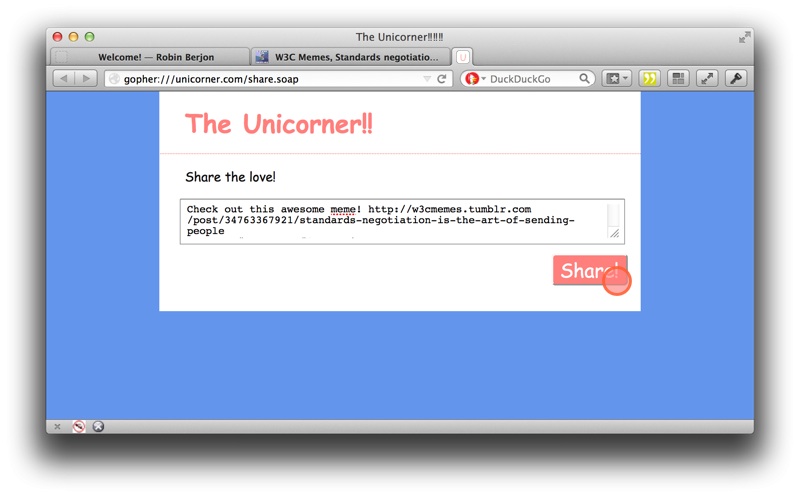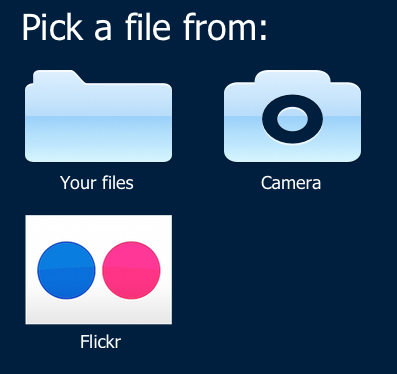Usage Scenarios
This section details a variety of usage scenarios for Wishes in order to help define how exactly they should work.
Note that all code examples are provisional and use completely made up syntax. The scenarios rely on the following loose terminology (to be tightened up when the view is clearer).
- application
- A regular Web application running in the user's browser, and typically calling upon wishes in the following scenarios.
- wish service
- A Web page written in such a way that it knows how to grant a wish and that exposes functionality to the application in that way.
Fire & Forget
This is the simplest case. Here the application formulates a wish but does not care about any return value, or even about the success, of the wish.
A typical example is the wish to share. The user is visiting an application page, finds it most cromulous, and wishes to share it with the world at large.

Creating a share button is a simple matter of attaching a handler to it and formulating a wish.
<button id='share'>😻 Share this!</button>
<!-- … -->
<script>
document.querySelector("#share").onclick = function () {
new Wish("share", "text/plain", location.href).make();
};
</script>
The user is then presented with a list of wish services that she has installed in her user agent (or, possibly, more generally on her operating system). Of these she selects the “Unicorner” social sharing site where she can share with her fellow unicorns.

The wish service picker requires no work from the developer and is entirely handled by the user agent. The list matches wish services that the user agent knows can fulfil this wish (this can comprise those installed by the user, but can also come from other sources such as system application, a specialised search engine, etc.). Installing a wish into a user agent is covered in a later section.
The “Unicorner” web site, which is a social sharing web site that the user happens to like (here showing how Wishes can help open up the Web to new contenders without having to battle the inertia of millions of authors having to add new buttons to their pages), opens up atop the application being shared (with some sort of signal that the wish service is related to the application — all of this is naturally implementation-dependent). The user can interact with it and hit “Share”.

There are two essential parts to the wish service's handling of the wish. The first part is being notified of the wish, including of the wish's payload and acting accordingly in order to grant it. The code for this is straightforward.
<textarea id='content'></textarea>
<button id='unishare'>Share!</button>
<!-- … -->
<script>
window.onload = function () {
if (currentWish)
document.querySelector("#content").value = currentWish.data;
};
document.querySelector("#unishare").onclick = function () {
// …code to actually post the message to the site…
if (currentWish) currentWish.grant();
};
</script>
Note that the code above still needs to call grant() on the wish once the
action is completed, even though it is returning no data to the application. This
tells the user agent that the wish is granted and it can use that notification for
instance to close the tab containing the wish service.
Return Value
While “fire & forget” wishes definitely have their uses, it is common for applications to expect data to be returned from the interaction with a wish service.
In this scenario we consider the following workflow: a user wishes to create a hilarious
meme, and goes to a meme publishing web site for that purpose. The meme publishing
web site first asks the user to pick an image to serve as the starting point for the meme.
That operation relies on <input type=file> in order to show how wishes
can integrate with that part of the platform. Then it will offer to edit the image, using
a wish to edit.
In both cases, data is returned from the wish service, and in the second case data is also received by it.
The application's UI is simple:

Clicking the first “Pick a picture” step hits an <input type=file>
control, which in fact just formulates the wish to pick a file. To give a better idea for
how this works, here is how you would get a list of files from a file input type.
<input type="file" accept="image/*" multiple id="uploads">
<script>
document.querySelector("#uploads").onchange = function (ev) {
handleFiles(Array.prototype.slice.call(ev.target.files));
};
</script>
And here is the equivalent code using a wish:
<button id="uploads">Upload</button>
<script>
document.querySelector("#uploads").onclick = function () {
new Wish("pick", "image/*", { multiple: true }).then(handleFiles);
};
</script>
These come out at the same amount of code. With the wish we need to handle clicking
ourselves which the file input type provides free, but if you ever wish to style your
file input control then that's a plus because you will need this sort of indirection
anyway. A positive side effect of the wish side is that you don't need no stinking
FileList.
It is important that the file input type and the wish to pick produce the same user experience since to the user, who neither knows nor cares for the page source, they are the same operation.
For the code examples we use the multiple attribute in order to
demonstrate its mapping, but the MemeCat application naturally only wants a single
image.
Irrespective of how MemeCat chose to implement its file picking, the user would be presented with the familiar wish service picker:

A wish service that knows how to grant a pick (of any kind) will return either
a File or an array thereof depending on the value of the
multiple field. Such a service could be implemented using code of the kind
that follows:
<div id="pics">
<-- a list of images that can be clicked to select them -->
</div>
<script>
document.querySelector("#pics").onclick = function (ev) {
if (ev.target.localName.toLowerCase() !== "img") return;
if (!currentWish) return;
var xhr = new XMLHttpRequest();
xhr.open("GET", ev.target.src);
xhr.responseType = "blob";
xhr.onload = function () {
var file = new File(xhr.response
, ev.target.src.replace(/^.*\//, "")
, { type: xhr.getResponseHeader("Content-Type") }
);
currentWish.grant(currentWish.data.multiple ? [file] : file);
};
xhr.send();
};
</script>
Once the MemeCat has obtained a picture file, editing it is no harder.
<button id="edit">Edit</button>
<script>
document.querySelector("#edit").onclick = function () {
new Wish("edit", file.type, { content: file }).then(handleMeme);
};
</script>
It is simply a wish to edit the given file MIME type, operating on the provided content. Once done the edited content is sent back using the same mechanism as for the file picker. It is worth noting here that it is entirely possible for this wish to be granted by a native application (so long as the user agent knows how to interact with the platform's conventions that support such communication).
Sharing can then be supported just as it is in the first section.
Explicit Wish
It is conceivable that there are cases in which an application may wish to operate with just one explicitly well-defined wish service, making use of the wish conventions for communication (likely because they are already supported by a given service) but without giving the user the opportunity to choose the service (presumably because it may result in a predictably poor decision).
To take the MemeCat example again, it is likely that the image source should be open-ended, but the service might wish to enforce a given editor service that consistently enforces Web meme conventions relying on the Impact font, specific stroke and fill, etc. where a general-purpose image editor might let the user overlay her cat picture with, say, Comic Sans text — clearly a bad thing.
Making an explicit wish to edit can be done as follows:
<button id="edit">Edit</button>
<script>
document.querySelector("#edit").onclick = function () {
new Wish("edit", file.type, { content: file })
.explicit("http://cool-editor.meme")
.then(handleMeme);
};
</script>
It is unclear at this point whether explicit memes are required in an initial instalment of this technology.
Installing a Wish
So far we have looked at scenarios involving formulating wishes from the application's point of view, as well as how a given wish service might reply. However in order for a service to grant a wish, the user agent needs to know about it.
There are many ways in which a user agent can become aware of wishes that it can offer as options to the user when needed. Here is a non-exhaustive list:
- Explicit installation
- The user may explicitly wish to “install” a given application as part of a list of wishes. This may happen if the Web application itself is being installed (something which can happen in some contexts), or as a form of bookmarking specific to wishes. When visiting a site offering a wish service, the user agent may provide an affordance for the user to specifically perform this action. Alternatively, it could be made possible for Web applications to give users a way of installing them (instead of relying on UA UI, which Web developers are often hesitant to.)
- Remembered navigation
- As the user navigates across the Web, her browser will come across pages that are declaring wishes. While having wish picker dialogs immediately show all such wishes would be a bad idea in that it would encourage spamming of that dialog (and even without malicious intent would likely cause it to be overcrowded), it can nevertheless be a good idea for browsers to remember that information so as to be able to offer those sites as options, notably in case no other known service can grant a given wish.
- Wish Search
- The wish picker could expose a search affordance that would make it possible to find wishes across the Web using a dedicated search engine.
- Built-in or default wishes
- User agents would likely ship with a number of wish services that they would grant themselves (e.g. the wish to pick a file for instance). Likewise, they could have a list of pre-configured services for various wishes.
- Platform wishes
- The browser can query the platform it is running on to find out if there are local applications that could grant a given wish.
A wish is in effect nothing more than a Web application that can be interfaced with programmatically following a specific interface. A wish service simply needs to express a little bit of metadata so that it can be recognised by user agents, crawlers, etc., but that metadata is very similar to that which can be used to describe a Web application.
Because of that, wish services can declare themselves using additional information from web apps manifest [[!appmanifest]]. Manifests can be linked in the usual manner:
<link rel="manifest" href="memecat.json">
This entails that any process exposed by the browser to install the wish would work through installing the application. If there are cases in which one desires to solely make the wish “installable” then a different syntax (but using the exact same JSON) can be used:
<link rel="wish" href="memecat.json">
The JSON itself is an extension to the basic web apps manifest format.
{
"name": "Unicorner"
, "icons": [{
"src": "icons/lowres.webp"
, "sizes": "64x64"
, "type": "image/webp"
}
, {
"src": "icons/hd.png"
, "sizes": "128x128"
}]
, "start_url": "/index.html"
, "wishes": [{
"name": "Edit"
, "start_url": "/wish/edit.html"
, "action": "edit"
, "types": ["image/*"]
, "icons": [{
"src": "icons/edit.webp"
, "sizes": "64x64"
}]
}
, {
"name": "Share"
, "start_url": "/wish/share.html"
, "action": "share"
, "types": ["text/plain"]
}
, {
"name": "Pick Media"
, "start_url": "/wish/pick.html"
, "action": "pick"
, "types": ["image/*", "video/*", "audio/*"]
}]
}
Authors traditionally do not like to have to rely on UA affordances (because it means they can't emphasise it if needed, also when explaining to users one needs to document for each browser, stay up to date, etc.). If installing pages (in a sense specific to the Web) becomes more mainstream, it would likely be welcome to support installation from actions carried out inside of the viewport. Such a mechanism is not, however, catered to at this point.